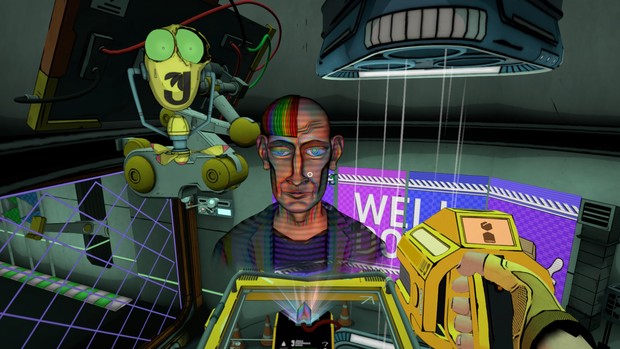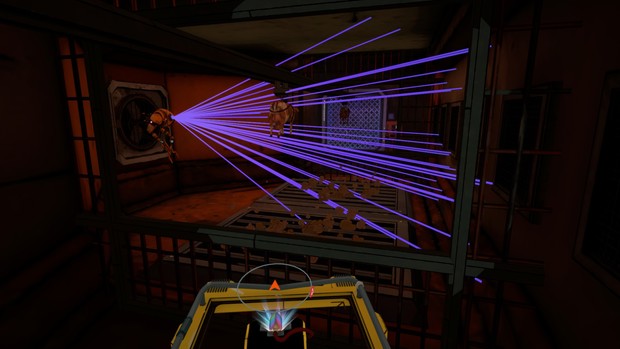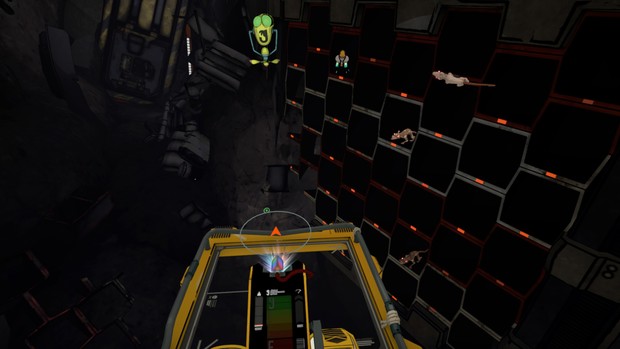The Last Worker review

- 0 Comments
Action-adventure comes packaged with assorted strengths and weaknesses
A game shouldn’t feel like a chore. Most of the time, anyway. An exception to that rule would be The Last Worker, a 3D first-person adventure in which you’re supposed to spend a good chunk of time on the job. The irony is that the game shines brightest in its proverbial 9 to 5 when you’re tasked with performing your assigned duties, while your “play” time can feel like much more of a grind due to some finicky action elements that emphasize a control scheme that’s a bit wonky even at its best. The presentation is slick, and some well-acted sidekicks are amusing throughout, but an intriguing narrative premise doesn't feel fully assembled and the entire operation just never seems to run quite as smoothly as it should.
Working at a city-sized fulfillment center for Jüngle, Kurt is the only survivor of the megacorporation’s purge and replacement of all human employees – including his pregnant girlfriend – with automated machines. The husky, bushy-bearded protagonist looks a lot like his voice-over counterpart, Ólafur Darri Ólafsson, as seen through the side mirror of his JünglePod, a kind of slow-moving “flying mobility scooter.” It’s a lonely existence, his only company being the occasional broadcast of a half-rainbow-haired company president and a glitchy, foul-mouthed flying Co-Bot named Skew, amusingly voiced with a thick (Scottish?) accent by a nearly unrecognizable Jason Isaacs. Between shifts, Kurt retires to a little hideaway in a garbage dump so toxic that he can’t breathe at times without a mask. And he’s been at it twenty-five long years – so long he’s forgotten what life is even like on the outside, although from the snippets of news you hear and the nature of the items you’re processing, it seems that things beyond these walls aren’t that much better.
Kurt has spent the last 9125 days (and counting) shuffling packages either for delivery or recycling according to certain criteria. It sounds rather monotonous – and it probably would be as a career, but it’s a pleasingly engaging diversion for the few hours you’ll spend doing it. There’s an element of Papers, Please to the process, in which you must actively determine which packages are fit for shipping and which will probably end up in the junkpile back at home sweet home. A handy tracer will highlight the path to your next assigned target among the endless rows of labyrinthine rooms filled with compartments. Once there, you must decide if it meets the prescribed weight and size requirements, then check it for any damage, labeling defective ones with the proper sticker before transporting them to the correct dispatch chute. This is the only part of the game that really qualifies as a “puzzle,” so I was hoping for more criteria to be introduced as I went along. However, other than packages with rush deliveries and a few seasonal parcels whose mixed results confused me, the job never gets any more complex.

Nevertheless, it took me a minute to come to grips with the basics, even after a mandated tutorial that Kurt complained he didn’t need. But once I did, I started enjoying myself and I felt a little burst of pride whenever I correctly routed a package. You only have about five minutes per shift to correctly process enough items to earn a passing grade; fail and you’re fired. Once you get the hang of what you’re doing, though, it shouldn’t be at all difficult to avoid the pink slip, because there’s plenty of time and grading seems very forgiving. If you want a higher ranking, there’s an option to replay a shift, which I did a couple of times early on just to get more practice, but I noticed no additional benefit for doing so.
There is an incentive for doing more than the bare minimum, however, because a holographic display of your parcel’s contents will appear upon delivery, and the items are often silly fun, like edible toilet paper, “nun-chuks” with a pair of sticks decorated like scowling sisters, a cat butt tissue dispenser, and a dogwalker drone. “Who buys this %@$&” wonders Kurt periodically, a rather pointed and entirely accurate commentary on our overly commercialized consumer society of crap. (Although I’d actually like a dogwalker drone. Get on it, Amazon.) There are 110 possible items to process, which you can review any time from the main menu, though even with a few replayed shifts, I only ever got about half of them.
It’s after hours when The Last Worker changes things up. Not unlike Portal, which clearly inspired this game either directly or indirectly, you soon have reason to go exploring the facility in ways that Jüngle obviously never intended. Another flying bot appears, equally well-acted by Clare-Hope Ashitey, stating that she represents an activist organization looking to take down the company from the inside, with you being their only remaining chance at sabotage. Following her lead, you’ll traverse the vents and tunnels and hidden areas of the facility. Surprisingly, you don’t actually see much in the way of illicit operations that might cause you to sympathize more with the rebels, other than the automated processing of whole cows into blocks of meat (though I daresay it’s probably quicker and less bloody than our own slaughterhouses).

In fact, while the spectre of end-stage capitalism is prevalent throughout the game, it’s never really delved into very deeply. Jüngle’s propaganda claims they’re “delivering dreams,” the activists say they’re peddling “death and destruction in family packs,” but Kurt really just wants to do his job and not think about it. When the stakes become much more personal, he is forced to finally rouse himself to action, but even then he seems to do so only with weary resignation. The story culminates in a choice of three possible endings about five hours in, but I can’t say a strong case had been made for any particular option – a fact reinforced by two of the outcomes completely contradicting each other rather than being variations on the same possible reality. The third finale, meanwhile, could have been the most poignant by far, but no attempt was made to seize the opportunity before the credits rolled, robbing it of any emotional impact. Strange. At least it’s easy enough to reload the final segment to check out the alternate versions.
The bigger change to the off-road sections is the gameplay itself. Since you’re going places where trespassers aren’t welcome, you’d best be prepared for additional challenges and even some opposition. The latter half of The Last Worker becomes far more action-oriented than I expected, and not in a good way. There are stealth sections in which you must sneak or “speed” your way past patrolling drones without being spotted, a shooting scene in which you must protect a defenseless ally, a few front-to-back arcade obstacle courses in which you remote-control Skew, a race that may or may not be winnable, several Quick Time Events spanning a range of annoyance levels, and a punishing timed sequence where you must complete two pattern-matching minigames on opposite sides of a room without being caught by a roving sentry, who resets your progress if you don’t finish one in time. All are doable, but expect to fail a number of times for at least some of them. Thankfully, several have mid-sequence checkpoints, and those that don’t will simply start you back at the beginning automatically.
The worst offender of all is a multi-part series of rooms that tasks you with shooting a beacon through tiny windows to lure away a lightning-fast robot. The problem, as it is to varying degrees throughout the entire game, is the controls, which are clunky at best and a hindrance at worst, either with a gamepad or a keyboard/mouse combo. You spend almost the entire time in your hovercart, which is fun to glide around in both vertically and horizontally while sorting packages under no particular duress. The world’s slowest “boost” feature barely increases your momentum, injecting no sense of exhilaration, and there’s one tutorial scene in which you must use it only in the precise position intended or it fails to initialize at all, killing you and forcing you to try again.

Fortunately speed is rarely an issue, but that still leaves the awkward JüngleGun equipped on the right arm of your JünglePod. (Just assume “Jüngle” precedes every non-proper noun I refer to.) The default mode is a kind of attractor/repulsor that lets you grab movable items from a distance, then pull in, rotate, and either release or ready them for throwing, but the mechanics feel unintuitive and clumsy. It’s one thing to accidentally drop a package you’re trying to deposit in a receptacle, but quite another to see a projectile bounce harmlessly away from a target one foot away with a killer bot bearing down on you. You’ll acquire other attachments as you progress, but all of them suffer from the same general awkwardness. I played largely with a gamepad, but the one main shooting segment proved so frustrating, even with “aim assist” enabled, that I switched to mouse and keyboard just for that and succeeded the first time rather easily. Indeed, some of the mechanics feel much more intuitive with a gamepad and others with keyboard/mouse, which is hardly an efficient way to play.
I should note that The Last Worker can also be played in VR. Unfortunately I wasn’t able to test it that way, because the game seems like it was designed for the more tactile feel of VR hand controllers that just isn’t possible with standard control schemes. It isn’t that the game is ever unplayable otherwise, just never really comfortable, and the more challenging the sequence, the more pronounced it becomes.
Another problem is that instructions aren’t always clearly conveyed. Along with the rushed tutorial, there’s an information page that updates with new features, but the cockpit of your vehicle is unlabeled and cramped, especially when you drop your package there as well, so visually it’s a bit disorienting at first. Perhaps more confusingly, it’s never clear when additional objectives have been introduced to your daily work shifts. Two different times I passed my evaluation, oblivious to the fact that I’d failed in my secondary mission and was forced to replay it anyway. And yet when I realized that and selected the “replay mission” option, the secondary objective was no longer available! The only way to re-enable it was to let the game restart the day over again. I don’t mind games refusing to hold a player’s hand, but learning through losing isn’t a very user-friendly design choice.
If the thought of a lonely life in a cavernous warehouse sounds a bit dreary, the experience is leavened somewhat by the interesting choice to present it all in a graphic novel-style aesthetic designed in collaboration with comic artist Mick McMahon (Judge Dredd, 2000 AD). It’s still just a bunch of aisles and shelves, metal and machines with no regard for anything but functional utility, and yet the hand-drawn look gives the environment a more personal feel. Animations are smooth, and there’s always a bot or two flitting around somewhere nearby. The mechanized atmosphere is complemented by the whirs of your JünglePod and the sounds of other automated equipment throughout, backed intermittently by a solemn synth score that provides a suitably subtle ambience. Given the level of talent on board, the voice acting is predictably excellent, although it struck me that the taciturn Kurt remained a bit too glib and subdued even after all hell began to break loose and theoretically should have turned his life upside down. I know I’d have been doing a lot more freaking out in his shoes.
Final Verdict
My mixed impressions of The Last Worker can be sorted much like the packages of Jüngle’s fulfillment center. Enough elements pass inspection for a lukewarm recommendation, including the stylish presentation, wisecracking sidekicks, top-notch voice acting, and the inherent fun of freely zipping (well, puttering) about in a flying vehicle, deciding the fates of people’s disposable desires. And yet other aspects are better suited to the “recycle” chamber for fine-tuning, most of them involving timed action sequences that bring out the worst of some already dicey (non-VR) controls. The story, too, though it touches on some relevant themes, is explored too superficially to really be effective, which feels like a missed opportunity. I enjoyed more of my time with this game than not, but hardcore adventurers had best steer clear, and even those with more action experience may find it taxing on occasion. If you’re looking for a good time with a bit more oomph than a traditional point-and-click, The Last Worker generally delivers; just brace yourself for the ride to get a little bumpy at times.
Hot take
The Last Worker offers an intriguing blend of gameplay elements, but it labours under some dodgy mechanics and questionable design decisions.
Pros
- Fun to hum around vertically and horizontally in a hovercart
- Routing packages for a living is surprisingly entertaining
- Well-acted sidekicks make for amusing companionship
- Stylish 3D presentation with a hand-drawn look
Cons
- PC controls are clunky and unintuitive
- Timed and/or action segments can be fairly punishing
- Story is too scattershot to be emotionally impactful
Jack played The Last Worker on PC (non-VR version) using a review code provided by the game’s publisher.










0 Comments
Want to join the discussion? Leave a comment as guest, sign in or register.
Leave a comment